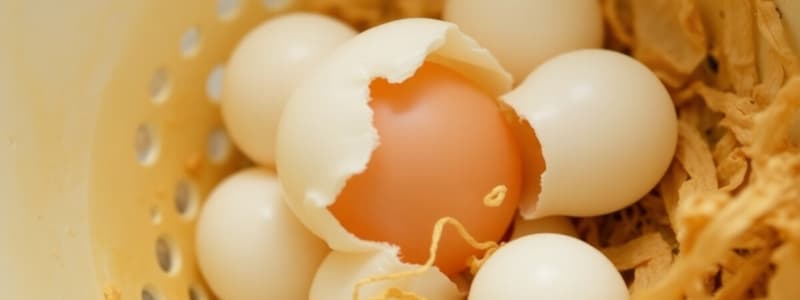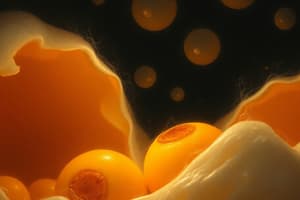Podcast
Questions and Answers
What is a characteristic feature of external fertilization?
What is a characteristic feature of external fertilization?
- Massive release of eggs and sperms into the environment. (correct)
- Sperms directly penetrate the eggs within the parent.
- Fertilization occurs in the body of the mother.
- Gametes are fused inside the female body.
Which of the following best describes ovoviviparous reproduction?
Which of the following best describes ovoviviparous reproduction?
- Embryos rely on the mother for nourishment through a placenta.
- Eggs develop inside the female and hatch while still inside her. (correct)
- Fertilization happens inside the male before transferring to the female.
- Fertilized eggs are laid outside and develop independently.
What is a defining trait of parthenogenesis?
What is a defining trait of parthenogenesis?
- Development of embryos without fertilization. (correct)
- Fertilization happens with both male and female gametes.
- Eggs develop into embryos only after mating.
- Fertilization only occurs in water environments.
Which of the following statements is true about viviparous reproduction?
Which of the following statements is true about viviparous reproduction?
What distinguishes oviparous reproduction from other reproductive strategies?
What distinguishes oviparous reproduction from other reproductive strategies?
Which type of egg has a very large amount of yolk that occupies the entire free space of the cell?
Which type of egg has a very large amount of yolk that occupies the entire free space of the cell?
In which type of egg is yolk concentrated in the lower part of the cell?
In which type of egg is yolk concentrated in the lower part of the cell?
Which type of egg is characterized by having yolk homogeneously distributed throughout the cell?
Which type of egg is characterized by having yolk homogeneously distributed throughout the cell?
In which type of egg is the yolk distributed around the nucleus?
In which type of egg is the yolk distributed around the nucleus?
What is the primary role of yolk in ova?
What is the primary role of yolk in ova?
What is a key characteristic of viviparous reproduction?
What is a key characteristic of viviparous reproduction?
Which statement correctly describes oviparous animals?
Which statement correctly describes oviparous animals?
In ovoviviparous reproduction, which of the following is true?
In ovoviviparous reproduction, which of the following is true?
What does parthenogenesis refer to?
What does parthenogenesis refer to?
Which of these organisms typically reproduces via parthenogenesis?
Which of these organisms typically reproduces via parthenogenesis?
Which type of fertilization describes the process where the eggs remain in the female's body until fertilized?
Which type of fertilization describes the process where the eggs remain in the female's body until fertilized?
What is the primary nutritional source for embryos in oviparous animals?
What is the primary nutritional source for embryos in oviparous animals?
Which of the following describes the cleavage stage of embryonic development?
Which of the following describes the cleavage stage of embryonic development?
In the context of reproductive mechanisms, how do viviparous organisms nurture their embryos?
In the context of reproductive mechanisms, how do viviparous organisms nurture their embryos?
What distinguishes viviparous animals from oviparous animals?
What distinguishes viviparous animals from oviparous animals?
Flashcards
Zygote
Zygote
A fertilized egg formed by the union of sperm and egg.
Gametes
Gametes
Reproductive cells (sperm and egg) that carry genetic material.
Fertilization
Fertilization
The fusion of male and female gametes (sperm and egg) to form a zygote.
External fertilization
External fertilization
Signup and view all the flashcards
Isolecithal ovum
Isolecithal ovum
Signup and view all the flashcards
Surrounding Environment
Surrounding Environment
Signup and view all the flashcards
Mesolecithal ovum
Mesolecithal ovum
Signup and view all the flashcards
Centrolecithal ovum
Centrolecithal ovum
Signup and view all the flashcards
Telolecithal ovum
Telolecithal ovum
Signup and view all the flashcards
Oviparous
Oviparous
Signup and view all the flashcards
Yolk distribution in ova
Yolk distribution in ova
Signup and view all the flashcards
Viviparous
Viviparous
Signup and view all the flashcards
Oviviparous
Oviviparous
Signup and view all the flashcards
Parthenogenesis
Parthenogenesis
Signup and view all the flashcards
Cleavage
Cleavage
Signup and view all the flashcards
Blastula
Blastula
Signup and view all the flashcards
Embryonic Development
Embryonic Development
Signup and view all the flashcards
Blastomere
Blastomere
Signup and view all the flashcards
Study Notes
Oogenesis
- Oogenesis is the production of ova (eggs) in the female body, specifically in the ovary.
- The process has three stages: multiplication, growth, and maturation.
Multiplication Phase
- Repeated mitotic divisions occur in primordial germ cells within the ovary.
- These divisions result in the creation of a large number of oogonia (2n).
Growth Phase
- Oogonia grow significantly in size during this phase.
- They develop into primary oocytes (2n).
Maturation Phase
- Each primary oocyte undergoes meiosis in two successive stages.
- The first division produces two unequal cells. One is a large secondary oocyte, and the other is a small first polar body.
- Both the secondary oocyte and the polar body are haploid (n).
- The second meiotic division of the secondary oocyte forms a mature ovum (n) plus another polar body (n).
- The polar bodies will eventually disintegrate.
Types of Ova Based on Yolk
- Ova are classified based on the amount and distribution of yolk.
- Isolecithal: Small, homogeneous yolk distribution throughout the cytoplasm (e.g., amphioxus)
- Mesolecithal: Moderate amount of concentrated yolk in the lower part of the cell, the animal pole (e.g., toads).
- Centrolecithal: Moderate amount of yolk distributed around the nucleus in the center of the cytoplasm (e.g., insects).
- Telolecithal: Large amount of yolk filling most of the cell, pushing the nucleus and cytoplasm to one side in a germinal disk (e.g., birds).
Fertilization
- Fertilization is the fusion of male gametes (sperm) with female gametes (ova) to form a fertilized egg (zygote).
- There are two main types of fertilization:
- External Fertilization: Gametes are released into the surrounding water. Many gametes are needed to overcome losses. (e.g., most fish, some amphibians)
- Internal Fertilization: Eggs remain in the female's body until fertilization by sperm introduced during copulation.
Types of Animals Based on Fertilization
- Oviparous: Separation between the mother's and embryo's blood; nutrition from yolk; embryo hatches outside the body (e.g., birds).
- Viviparous: Connection between the mother's and embryo's blood; nutrition from mother's blood; live birth (e.g., mammals).
- Oviviparous: Separation between mother's and embryo's blood; nutrition from yolk; embryo hatches inside the body (e.g., sharks).
Parthenogenesis
- Parthenogenesis is the ability of the egg to develop without fertilization.
- It can occur naturally in some species (e.g., ants, bees) or artificially.
Embryonic Development
- Embryonic development follows three main stages:
- Cleavage: Repeated mitotic divisions of the zygote to form blastomeres.
- Gastrulation: Blastomeres arrange to form ectoderm, mesoderm, and endoderm.
- Organogenesis: Differentiation of tissues and organs from germ layers.
Studying That Suits You
Use AI to generate personalized quizzes and flashcards to suit your learning preferences.




